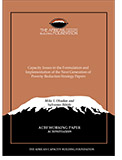
Although economic growth is widely acknowledged to be crucial for poverty reduction and for sustaining development, efforts aimed at tackling these challenges in Africa did not, for a long time, yield the desired results. The decade of the 1980s was thus deemed a lost decade for Africa despite the plethora of development initiatives and a sea-change in the policy landscape. In recent years, however, Africa’s growth performance has improved significantly, though shy of the 7 – 8 per cent required to halve poverty by 2015. With Africa’s low economic performance over the three decades to 2000, it is hardly surprising that it remains the poorest continent in the world. Sub-Saharan Africa has the highest poverty incidence in relation to the other regions in the world (41.1% in 2004 compared to 9.0% for East Asia and Pacific and 8.6% for Latin America and Caribbean). It was against this background that the Bretton Woods Institutions (World Bank and IMF) introduced the Poverty Reduction Strategy Paper (PRSP) in 1999 as the fundamental principle for both their loan policies and the extension of debt relief to heavily indebted poor countries (HIPCs).





